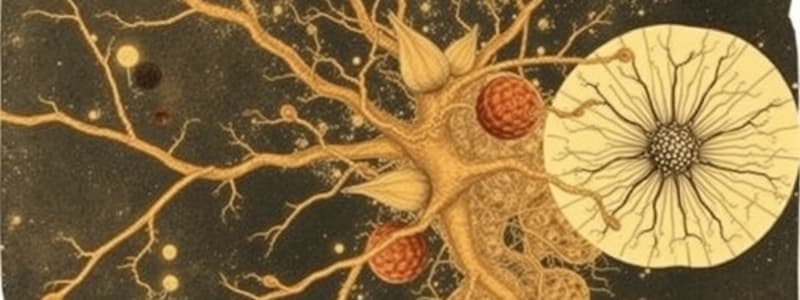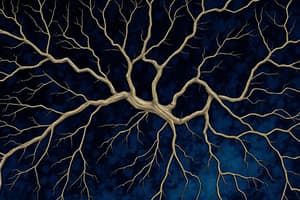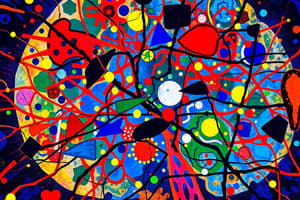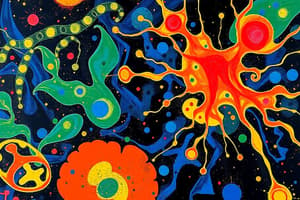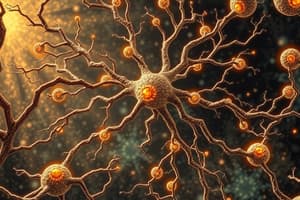Podcast
Questions and Answers
What major theory did the neuron doctrine replace?
What major theory did the neuron doctrine replace?
- Neural networking theory
- Spinal reflex theory
- Cell theory
- Reticular theory (correct)
Which technique was developed by Camillo Golgi to enhance the visualization of nerve cells?
Which technique was developed by Camillo Golgi to enhance the visualization of nerve cells?
- Magnetic resonance imaging
- Silver nitrate staining technique (correct)
- Gadolinium enhancement
- Fluorescent dye technique
What significant advancement in neuroscience occurred in the 1950s regarding neurons?
What significant advancement in neuroscience occurred in the 1950s regarding neurons?
- Discovery of neurotransmitters
- Identification of synapses (correct)
- Invention of the electron microscope
- Development of neural plasticity theory
What was the primary method Santiago Ramón y Cajal used to communicate his observations of the nervous system?
What was the primary method Santiago Ramón y Cajal used to communicate his observations of the nervous system?
In what year did Cajal and Golgi jointly receive the Nobel Prize for their work in physiology or medicine?
In what year did Cajal and Golgi jointly receive the Nobel Prize for their work in physiology or medicine?
What method significantly changed Cajal's career and contributed to his observations of nerve cells?
What method significantly changed Cajal's career and contributed to his observations of nerve cells?
Which statement about the neuron doctrine is true?
Which statement about the neuron doctrine is true?
Cajal's observations showed that the nervous system is composed of what type of cells?
Cajal's observations showed that the nervous system is composed of what type of cells?
What was the primary effect of Cajal's modified staining technique?
What was the primary effect of Cajal's modified staining technique?
Which theory did Cajal's findings primarily contradict?
Which theory did Cajal's findings primarily contradict?
What was the primary focus of Santiago Ramón y Cajal's research?
What was the primary focus of Santiago Ramón y Cajal's research?
Which technique was crucial for Cajal's ability to visualize nerve tissue?
Which technique was crucial for Cajal's ability to visualize nerve tissue?
What significant advancement in microscopy occurred prior to Cajal’s work?
What significant advancement in microscopy occurred prior to Cajal’s work?
What specific technique did Camillo Golgi develop to enhance the visualization of nerve cells?
What specific technique did Camillo Golgi develop to enhance the visualization of nerve cells?
What belief did Cajal's research challenge regarding nerve cell organization?
What belief did Cajal's research challenge regarding nerve cell organization?
Which theory did Santiago Ramón y Cajal's work directly oppose?
Which theory did Santiago Ramón y Cajal's work directly oppose?
In what year did Cajal publish the first volume of his research?
In what year did Cajal publish the first volume of his research?
Why did Camillo Golgi continue to support the reticular hypothesis despite conflicting evidence?
Why did Camillo Golgi continue to support the reticular hypothesis despite conflicting evidence?
What characterized Santiago Ramón y Cajal's illustrations of the nervous system?
What characterized Santiago Ramón y Cajal's illustrations of the nervous system?
What did the neuron doctrine hypothesize about the structure of the nervous system?
What did the neuron doctrine hypothesize about the structure of the nervous system?
Flashcards
Histology
Histology
The study of microscopic anatomy, focusing on tissues and their structures.
Tissue staining
Tissue staining
A technique that uses dyes to highlight specific structures within tissues, making them visible under a microscope.
Reticular theory
Reticular theory
The idea that nerve cells form a continuous network, interconnected like a mesh.
Neuron doctrine
Neuron doctrine
Signup and view all the flashcards
Santiago Ramón y Cajal
Santiago Ramón y Cajal
Signup and view all the flashcards
Golgi's Method
Golgi's Method
Signup and view all the flashcards
Cajal's Illustrations
Cajal's Illustrations
Signup and view all the flashcards
Neuron
Neuron
Signup and view all the flashcards
Golgi's Reticular Hypothesis
Golgi's Reticular Hypothesis
Signup and view all the flashcards
Golgi's Illustrations
Golgi's Illustrations
Signup and view all the flashcards
Synapse
Synapse
Signup and view all the flashcards
Cajal's Drawings
Cajal's Drawings
Signup and view all the flashcards
